Birds are rapidly becoming important members of the household. As a results seeking veterinary attention for pet birds has become more common place. With the increased avian case load in veterinary practice (author’s experience) the need for in house examination of avian blood samples has also risen, and become an important diagnostic aid. With clinics treating birds more regularly collection methods have progressed from the quick and easy toe claw clip to the more diagnostically appropriate venipuncture (Krautwald-Junghanns, 2007). Venipuncture in avian species may be intimidating to begin with but with practice the process becomes almost as easy as routine venipuncture in a dog or cat. Simple blood analysis of a smear, packed cell volume (PCV) and total protein (TP) is a quick, simple and cost-effective diagnostic method that can be completed in house by veterinary support staff.
Toe clip
Venipuncture is necessary to obtain a diagnostically relevant sample, free of contaminants and collection artifacts that occur with the more traditional toe claw clip (Fudge, 2000). Toe claw clip samples are not as diagnostically useful, because the sample will be capillary blood rather than circulating blood which would provide differing results (Kramer and Harris, 2010). Blood obtained from toe claw clipping is often tainted with contaminates such as epidermal cells or fecal matter even with cleaning of the clipping area that could affect biochemistry results or provide false positives to pathogen detection (Morrisey, 1999). The blood from this collection method also tends to clot before enough is collected due to slow blood flow because of the laceration of capillaries rather than a vein and can stress the bird unnecessarily while trying to milk the blood out. The toe clip method is also painful when the clip is performed and with the squeezing of the toe to milk the blood. For all these reasons this is not an acceptable method for collecting blood from birds.
Indications for venipuncture
With venipuncture the quality and quantity of blood obtained allows more accurate and extensive diagnostic testing (Krautwaldjunghanns, 2007). With a few drops of blood (for PCV/TP and smear) anaemia can be diagnosed. With a little more blood, even 0.5 ml, full haematology can be completed (Mitchell and Johns, 2008). Many in-house diagnostic machines cannot process small quantities of blood. However, pathology laboratories are easily able to do so, and most will have reference ranges of different avian species at hand. Full biochemistry can be completed, which can be an indicator of organ function. Blood electrolytes are also diagnostically important and easy to analyze. Serology, DNA probes and viral cultures can also be performed on blood samples when attempting to diagnose specific diseases (Krautwald-Junghanns, 2007). Indications of the need for blood collection via venipuncture for anaylsis include wellness screening (especially for expensive breeding birds), screening for or diagnosing infectious diseases, evaluation of disease status and treatment or gender identification. Venipuncture can also be used for bolus fluid therapy or intravenous medication administration.
Precautions
There are additional precautions for birds, compared with mammals, for the collection of blood via venipuncture. The birds must be clinically stable. It is not worth stressing the bird, possibly to death to obtain a diag. Supportive care and stabilization may be required before venipuncture is attempted (Dyer and Cervasio, 2008). Depending on the health and temperament of the bird or even experience of phlebotomist a general anesthetic may be required but that too is not without risk (Curro, 1998). The smallest amount of blood required should be collected. The general rule is a maximum 1 ml of blood can be collected per 100 g of bodyweight which is 1% of bodyweight or 10% of blood volume (Kramer and Harris, 2010). The clinical condition, and degree of debilitation of the bird, should factor into the decision of the amount of blood to collect and what diagnostic test should be run (Fudge, 2000). Avian veins are more fragile and less forgiving than mammal’s veins, demanding the smallest gauge needle be used for venipuncture therefore requiring gentle collection technique to avoid heamolysis (Fudge, 2000) (Table 1).
| Body Weight (grams) | Needle gauge | Syringe size (ml) |
|---|---|---|
| <60 e.g. canary | 28–30 | Insulin 0.3–0.5 |
| 60–200 e.g. cockatiel | 25–27 | 1.0 |
| > 200 e.g. cockatoo | 25 or larger | 3.0 or larger |
As with any venipuncture and sample collection, organization is important. All collection materials and sample preparation equipment should be gathered and laid out for quick processing of the sample. Collection equipment required includes needles and syringes, glass slides, microheamacrit tubes and blood storage tubes relevant to required tests, these vary depending on in-house equipment or pathologists used. Materials for aseptic venipuncture are also required such as alcohol swabs and dry swabs for compression. The sample should be handled gently as avian erythrocytes are even more fragile than mammalian cells (Krautwald-Junghanns, 2007).
Venipuncture site
The venipuncture site will vary depending on species, size and condition of the bird. Due to the size of smaller birds the right jugular may be the only accessible vein for venipuncture. The right jugular is most commonly used as it is the largest and most accessible peripheral vein, especially for inexperienced phlebotomints (Dyer and Cervasio, 2008). The ulnar vein is readily accessible in all birds but is much smaller than the jugular and therefore can be hard to successfully obtain a sample. The medial metatarsal vein is generally the preferred vein for water birds as it is more readily accessible in these birds (Kramer and Harris, 2010). An important aspect to factor in the decision for a venipuncture site is how the bird will be restrained (Dyer and Cervasio 2008). An experienced phlebotomist can hold small to medium size birds and collect the sample themselves. Inexperienced phlebotomists should always have an experienced handler or general anesthetic to aid in the collection process (Curro, 1998) (Figure 1).
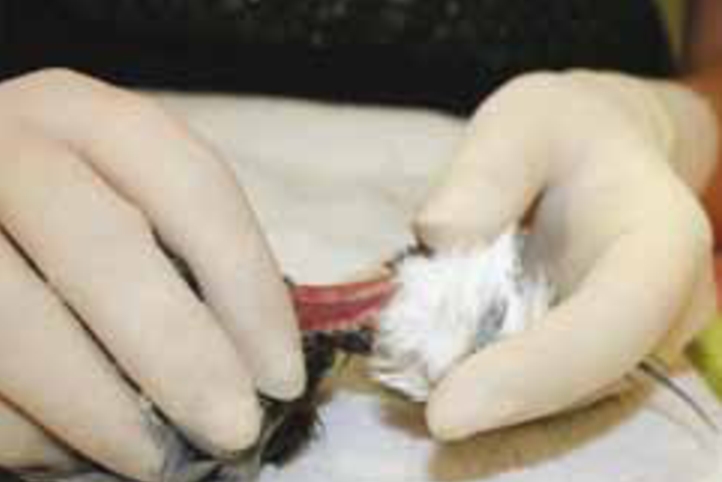
Jugular vein
The right jugular vein is preferred over the left as it is generally larger and more easily accessible in most pet bird species, the psittacine species, passerine species (Fudge 2000). The patient needs to be restrained in left lateral recumbency with extension of the neck required. Blowing gently on the feathers or wiping over the feathers with alcohol will expose the apterium which is the featherless tract of skin over the jugular furrow (Kramer and Harris, 2010).
Care should be taken not to over wet the bird with alcohol causing excessive heat loss of the patient (Curro, 1998). The jugular vein is raised by applying pressure to the base of the neck just cranial of the thoracic inlet. The skin over the jugular may be moved or the neck gently twisted to help visualize the vein. The needle should be introduced into the vein on a shallow angle, about 30°, with the bevel facing down. Introducing the needle with the bevel down means not as much of the needle needs to be inserted into the vein to obtain blood. This reduces the risk of vein laceration, or of puncturing through the other side of the vessel (Kramer and Harris, 2010). Aspiration of the blood should be gentle ensuring stability of the needle. As the needle is removed from the vessel pressure should be applied to prevent vessel leakage (Figure 2).
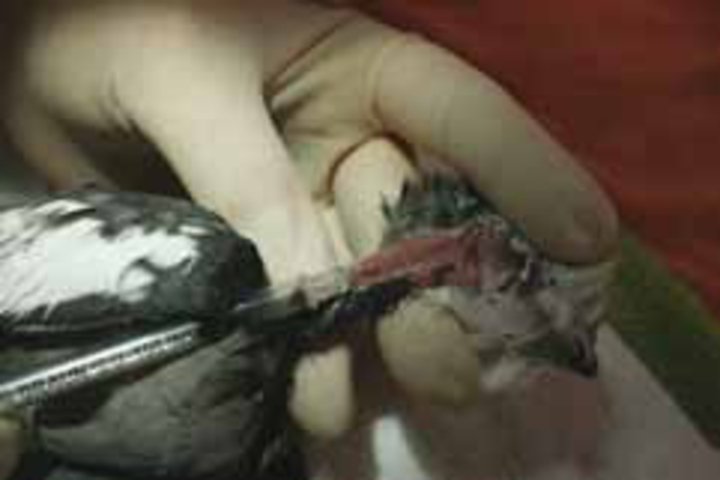
Complications from the site of venipuncture can include haematomas, which can be potentially fatal if the correct pressure to stop the bleeding is not applied as the anatomy of the neck allows expansion enough for a haematoma to exsanguinate the patient (Dyer and Cervasio, 2008). Haemotomas may develop from laceration of the vessel or puncturing through the other side of the vessel due to patient movement or poor technique. There is also the possibility of puncturing the cervicocephalic air sac which may cause the bird to cough up blood and cause respiratory distress (Kramer and Harris, 2010).
Ulnar vein
Ulnar (basilica) venipuncture requires more restraint than jugular venipuncture which may cause more stress, but complications are less severe due to the size and location of the vein not allowing for as large haematoma formation as in the neck (Kramer and Harris, 2010). The ulnar or wing vein runs over the medial aspect of the humeral-radioulnar joint (elbow). The ulnar vein is easily visualized by wetting with alcohol or may require plucking a feather or two if the bird is anaesthetized (Figure 3).
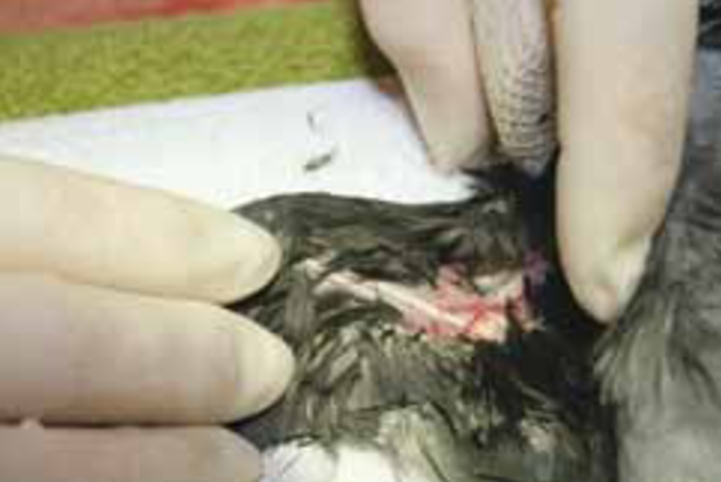
The ulnar vein is very superficial and fragile so correct restraint is very important. The patient should be restrained in dorsal recumbency with the phlebotomist positioning the desired wing for venipuncture. The phlebotomist's restraining hand is used to extend the wing and tilt the wing to raise the vein. If required the index finger of the restraining hand can be used to occlude the proximal aspect of the vein to help raise the vein. The needle should enter the vein on a shallow angle with the bevel facing down where the vein crosses the joint (Figure 4).
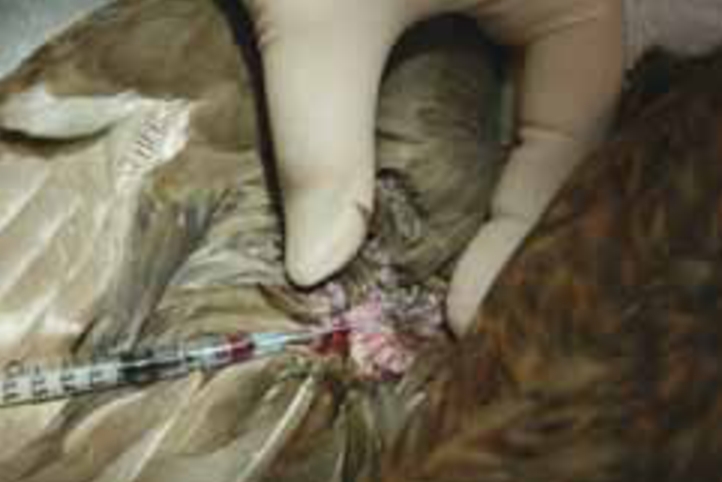
After the collection of blood, pressure needs to be applied across the whole joint for at least 2 minutes, as this vessel is prone to haematoma formation (Kramer and Harris 2010). However the size and position of this vein means a post venipuncture haematoma is not a critical complication as it can be in the jugular vein as there is not as much anatomical space for the formation of a haematoma.
Medial metatarsal vein
The medial metatarsal (caudal tibial) vein is located along the medial aspect of tibiotarsus crossing over the medial aspect of the tibiotarsus-tarsometatarsal joint, progress down to the dorsal medial aspect of the foot (Figure 5). This vein is most prominent in water birds but can be used in any bird with large enough vessels (Fudge, 2000). The patient can be restrained using any method that allows access to the vessel with the phlebotomist restraining the leg. If the bird is conscious having the handler restrain the bird tucked under their arm with the legs dangling down for the phlebotomist to access is in the author’s opinion generally best. Entry site to the vein depends on the bird’s anatomy, with entry attempted where the vein is most visible once occluded proximally.
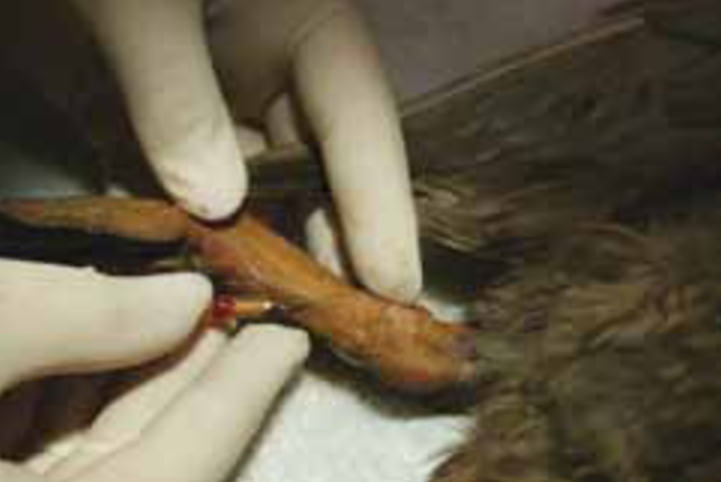
Depending on the bird species the best entry point may be covered with feathers or in the naked skin area, either way it should be cleaned using a 70% alcohol solution. The appropriate sized needle should be introduced into the vein on a shallow angle with the bevel facing up without the syringe attached to allow the blood to flow indicating the needle is in the vessel without damaging the vessel with the pressure caused by a syringe (Figure 6). Once the blood starts flowing into the hub of the needle attach the syringe and aspirate the sample. This vein is easy to occlude and rarely forms haematomas due to the lack of surrounding soft tissue but is harder to visualize than jugular or ulnar veins (Kramer and Harris, 2010).
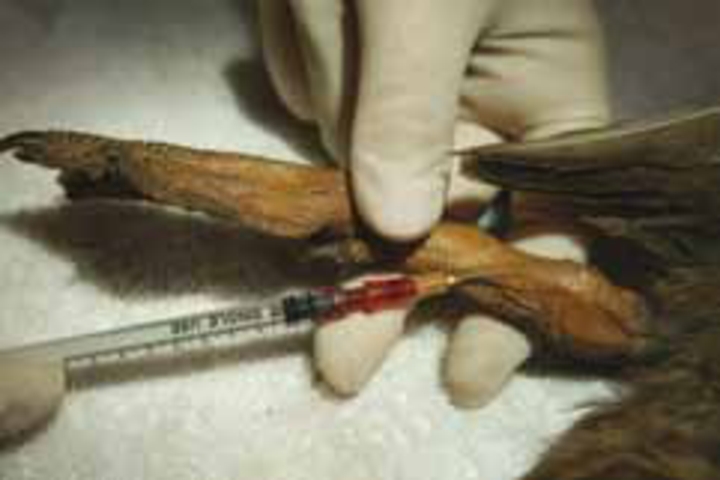
Conclusion
Avian venipuncture is very important to master, even for those inexperienced in dealing with birds. It allows the clinician to collect blood on which to run further diagnostic tests. This will help with drawing up a complete and accurate problem list for the avian patient, and can help with giving owners a guide to prognosis. It is cost effective and can be accomplished using various techniques that suit the phlebotomist. It is always important to check with the pathologist for the appropriate storage tube for the specified test.
